Whispering Angel – Cotes de Provence Rose
Are there Angels in Provence ???
Yes most definitely yes, a certain alluring and bewitching corner of Provence has thousands of Angels,  all pink with shimmering and enriching qualities. So captivating and ideal are the conditions in this magical corner of South East France that these celestial Angels secretly keep reproducing around the same time each year when the warm, misty, quiet mornings of autumn prevail. Although these Angels from Provence can be mysterious, enchanting and unquestionably unique, they are generally accessible to us Homo Sapiens, but like all known Angels in limited quantities only.
all pink with shimmering and enriching qualities. So captivating and ideal are the conditions in this magical corner of South East France that these celestial Angels secretly keep reproducing around the same time each year when the warm, misty, quiet mornings of autumn prevail. Although these Angels from Provence can be mysterious, enchanting and unquestionably unique, they are generally accessible to us Homo Sapiens, but like all known Angels in limited quantities only.
Some say Angels are divine messengers from heaven and portray paragons of virtue. Our Angels are certainly divine, heavenly, full of virtue and contain the purity of inner beings. Our special Angel is the “Whispering Angel” from Chateau d’ Esclans nestling on the outskirts of the charming village of La Motte, not too far from the well known coastal town of St. Tropez in Provence. “Whispering Angels”are born out of old grenache vines and live in the splendour of one of the most beautiful chateaux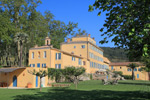 in the whole of France, these Angels lead a great life which can now be shared with you.
in the whole of France, these Angels lead a great life which can now be shared with you.
“Whispering Angel” is part of a kindred family with a distinguished hierarchy and substantial pedigree. This family is made up of the Finest Rose Wines in the World, Rose Wines of such class they need to be tasted to be believed. “Whispering Angel” belongs to a family  (excuse the gender) made up of the mother, the grandmother and the great grandmother as follows:
(excuse the gender) made up of the mother, the grandmother and the great grandmother as follows:
Chateau d’Esclans, Whispering Angel, is the beautiful baby
Chateau d’Esclans, Esclans, is the gorgeous mother
Chateau d’Esclans, Les Clans, is the gracious grandmother
Chateau d’Esclans, Garrus, is the resplendent great grandmother
How do we describe these extraordinary wines which grace the tables of many of the worlds finest Hotels and Restaurants, maybe first we should highlight the exceptional people behind this remarkable estate. It’s a huge challenge to turn a wine grouping like rose whose reputation as a good quaffing wine is ok, but not great, into a wine of substance that can now sit comfortably at the same table with great red and white wines like those from Bordeaux and Burgundy. This challenge was taken up by Sacha Lichine the owner of Chateau d’ Esclans and the son of the distinguished wine writer and past owner of Chateau Prieure Lichine in Margaux, Alexis Lichine.
Sacha is the driving force behind this accomplished enterprise, his intense 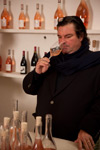 belief that rose wines could be propelled high up in the league of fine wine is equally matched by the investment he has committed and the astute move to persuade Patrick Leon out of retirement to take the lead as head winemaker. Patrick Leon one of the worlds leading winemakers has
belief that rose wines could be propelled high up in the league of fine wine is equally matched by the investment he has committed and the astute move to persuade Patrick Leon out of retirement to take the lead as head winemaker. Patrick Leon one of the worlds leading winemakers has 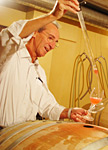 been a family friend for many decades and was before his original retirement the chief winemaker at Chateau Mouton-Rothschild and one of Patrick’s many claims to fame was his lead role with Robert Mondavi in developing Opus One at the Napa Valley winery in California, now one of the worlds greatest wines. With a great believer and a great winemaker success was inevitable.
been a family friend for many decades and was before his original retirement the chief winemaker at Chateau Mouton-Rothschild and one of Patrick’s many claims to fame was his lead role with Robert Mondavi in developing Opus One at the Napa Valley winery in California, now one of the worlds greatest wines. With a great believer and a great winemaker success was inevitable.
If we can get a little technical and discuss the actual wines and bearing in mind the significant variation in costs, then the inevitable question that comes to mind is what is the difference between Chateau d’Esclans and other Provence roses and what are the differences between Chateau d’Esclans’s own four roses.
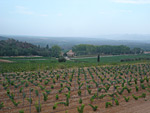 Its important we highlight the main differences between Chateau d’Esclans and other top Provence estates. First the Chateau predominatly uses Grenache from vines up to eighty years old for all of the four roses they produce and using this grape variety is unique in its own right.
Its important we highlight the main differences between Chateau d’Esclans and other top Provence estates. First the Chateau predominatly uses Grenache from vines up to eighty years old for all of the four roses they produce and using this grape variety is unique in its own right.
Secondly they adopted a unique process to Provence whereby 85 to 90 percent of all four roses are made from “free run juice” and limited very light and soft pneumatic pressings of between 0 to 2 bar for the remainder of the process.
The third major initiative is the meticulous and lengthy process of temperature control which starts with early morning harvesting with ice packs in each of the pickers basket, the grapes are then chilled before a short maceration process, then the juice is free run via gravity and the grapes own natural weight before a very limited and light pressing. The cooling process continues in the fermenting halls via refrigerated steel vats and yet another unique system for the wines stored in burgundy barrels, 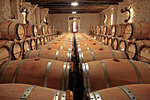 these barrels have cooling tubes located through the centre which manages a slow fermentation over 3 to 4 months which in turn produces special wines of great taste, complexity and fragrant aromas unlike no other Rose Wines in the World.
these barrels have cooling tubes located through the centre which manages a slow fermentation over 3 to 4 months which in turn produces special wines of great taste, complexity and fragrant aromas unlike no other Rose Wines in the World.
The select processes and creativity mentioned above are not only very uncommon in wine making, but very time consuming and costly and only by tasting the wines can one realize the significant difference between the rose wines of Chateau d’Esclans and other best in class growers. Skill, effort and commitment always reward in the end.
The following provides more detail regarding the individual wines:
Chateau d’Esclans, Whispering Angel—the grapes are selected from the south exposure of the vineyard. The grape varieties utilized are Grenache, Syrah, Cinsault, Mourvedre and Rolle (Vermentino). Maceration is at 10-12 C to extract maximum aromas. The assemblage has been made without barrel fermentation to keep the freshness and all the fruit flavours. This is a beautiful wine, delicately scented with lovely flavours and enchanting aromatics. Soft and round it displays layers of exotic and seductive fruit.
Chateau d’Esclans, Esclans—the grapes are selected from the best sections of the chateau, mainly from a south east exposure. 80 year old Grenache provides 39% of the juice, the balance of the Grenache being selected from 30 to 40 year old vines, some Rolle (Vermentino) is utilized to provide balance to the blend. The grapes are sorted manually three times with maceration following at 10 to 12 C to extract maximum aromas. The wine is partly vinified in demi-muids (500 to 600 litres barrels). The bottle bouquet of this class rose wine is powerful with an abundance of honey and melon sweet- smelling fruit. The underlying wine has an inner core of sumptuous and well proportioned fruit and acidity and a just fabulous finish.
Chateau d’Esclans, Les Clans—the grapes are selected from the best south east parts of the vineyard. Grenache is the primary grape variety with 45% harvested from 80 year old vines. A little Rolle (Vermentino) being included to balance the blend. The grapes are tasted and bunches individually selected all by hand in the vineyard early morning before moving on to the winery. Maceration takes place at 10 to 12 C to extract maximum aromas and then only free run juice is selected before pressing. Vinification is exclusively in demi-muids (500 and 600 litres barrels) for 7 months with burgundian style batonnage. This remarkable wine will age well for up to 5 years. A gorgeously complex wine with exceptional richness. This rose wine exhibits huge amounts of fragrance, admirable levels of concentrated fruit with a lovely long lasting fresh finish.
Chateau d’Esclans, Garrus—the grapes are selected from the best south east parts of the vineyard and harvested at optimum maturity. Grenache is the primary grape variety with 48% harvested from 80 year old vines. A little Rolle (Vermentino) being included to balance the blend. The grapes are tasted and bunches individually selected all by hand in the vineyard early morning before moving on to the winery. Maceration takes place at 10 to 12 C to extract maximum aromas and then only free run juice is selected before pressing. Vinification is exclusively in demi-muids (500 and 600 litres barrels) for 8 months with burgundian style batonnage. This top cuvee will age well for up to 5 years. Yes, stunningly opulent and sensationally concentrated, yet very cultured, this monumental rose has such intense flavours which release magnificent and compelling quotas of fruit as the wine leisurely cascades over the palate, with a gorgeous finish that lasts for ever and ever.
Remember— Agnetha, Anni-Frid, Benny and Bjorn all believed in Angels
HAPPY WHISPERING ANGEL DAYS
GRAHAM D
 Comments Off on Whispering Angel – Cotes de Provence Rose
Comments Off on Whispering Angel – Cotes de Provence Rose 